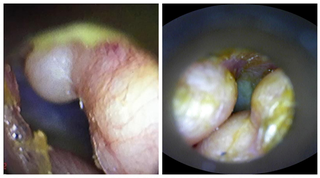Surfer’s ear is the common name for a condition caused by repeated exposure to cold water and wind.
It causes bony growth to develop within the ear and can lead to hearing loss.
The medical name for surfer’s ear is external auditory canal exostoses (EACE) or exostoses.
It doesn't just affect surfers. Anyone who is regularly in cold water is at risk of developing the condition.
This includes:
- open water swimmers
- surfers
- kayakers
Surfer's ear is a different condition to swimmer’s ear.
Symptoms of surfer's ear
Surfer's ear develops over time. It may take 10 to 15 years for the symptoms to appear.
The bony growth in your ear isn’t harmful. But it can form lumps in your ear and this can cause problems. You might be unaware that the condition is developing.
Symptoms of surfer's ear may include:
- recurrent ear infections
- water getting trapped in your ear
- hearing loss
If you do not see your GP to treat symptoms, your symptoms could get worse. If the lumps are very big, your ear canal could close over completely. This can lead to hearing loss.
Causes of surfer's ear
Surfer’s ear is caused by being out a lot in cold water and wind.
The bony growth happens because of the continuous change of temperature in the ear canal.
What happens is:
- Cold water regularly swirls along the ear canal.
- The body responds and warms the affected area.
- This triggers bone-producing cells in the ear canal.
- This causes the bone around the ear to develop a bony growth.
You're most likely to get surfer's ear if you're regularly in water below 19 degrees Celsius.
In Ireland, the temperature of sea water is usually always below 19 degrees Celsius. Even in the warmest months the average temperature is between 13 to 17 degrees Celsius.
Diagnosing surfer's ear

If you are worried you have surfer’s ear, talk to your GP.
Your GP will check your ears.
If they can't diagnose the condition, they may refer you to a specialist. This will be at your nearest Ear Nose and Throat (ENT) department. They will examine your ears further.
Treating surfer's ear
If your symptoms are mild, you may need to take a course of ear drops or antibiotics. Your GP will let you know.
If your symptoms are severe, you may require surgery. Follow your GP's advice.
Preventing surfer’s ear
The best way to reduce the risk of surfer’s ear is to wear earplugs when you’re in the water. It is a practical and cost-effective way to reduce the risk of surfer’s ear.
Your local sports shop should be able to give you advice on ear plugs suitable for water sports.
Swimmer’s ear
Swimmer's ear is a different condition to surfer's ear
Swimmer's ear is also known as otitis externa. It causes swelling of the outer opening of the ear and the ear canal. This canal is known as the external ear canal. It connects the outside of the ear to the eardrum.
Content supplied by Dr Seamus Boyle, ENT Department, Sligo University Hospital
Reviewed by Professor Nash Patil, President of the Irish Institute of Otorhinolaryngology/Head and Neck Surgery
